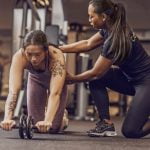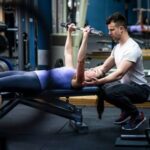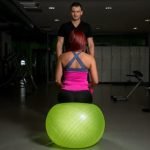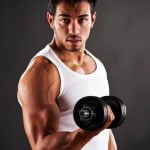Deadlifts are a fundamental exercise in any strength training routine, but where do deadlifts fit into workouts exactly? Deadlifts are a compound movement that targets multiple muscle groups simultaneously, making them incredibly efficient for building strength and muscle mass. In this article, we will delve into the world of deadlifts, exploring their benefits and importance in workout routines.
Deadlifts come in various forms, including sumo deadlifts, conventional deadlifts, Romanian deadlifts, and trap bar deadlifts. Each variation offers unique advantages and targets different muscle groups. Understanding the differences between these types of deadlifts can help individuals tailor their workouts to meet specific fitness goals and needs.
One key aspect of incorporating deadlifts into your workout routine is understanding the muscles worked during this exercise. The primary muscles targeted include the hamstrings, glutes, lower back, and core. By engaging these muscle groups with proper form and technique, individuals can develop overall strength and power while reducing the risk of injury. Stay tuned as we dive deeper into the specifics of deadlift variations, proper form techniques, and how to maximize the benefits of this powerhouse exercise.
Types of Deadlifts
Deadlifts are a versatile compound exercise that can be performed in various forms, each targeting slightly different muscle groups and providing unique benefits. Understanding the different types of deadlifts can help individuals tailor their workouts to their specific fitness goals and preferences. Here, we will explore four common variations of deadlifts: sumo deadlift, conventional deadlift, Romanian deadlift, and trap bar deadlift.
Sumo Deadlift
The sumo deadlift is characterized by a wider stance and grip compared to the conventional deadlift. This variation places more emphasis on the inner thighs, quads, and glutes while reducing stress on the lower back. Sumo deadlifts can be beneficial for individuals with mobility issues or those looking to target their lower body muscles more effectively. It also allows for a shorter range of motion compared to the conventional style, making it easier for individuals with limited flexibility.
Conventional Deadlift
The conventional deadlift is perhaps the most popular form of deadlifting, involving a hip-width stance with hands positioned just outside the legs. This variation primarily targets the hamstrings, glutes, lower back, and core muscles. It is an excellent exercise for building overall strength and power in the posterior chain. Proper form and technique are crucial when performing conventional deadlifts to prevent injury and maximize muscle engagement.
Romanian Deadlift
The Romanian deadlift differs from other variations as it involves a partial range of motion where the barbell is lowered towards the ground while keeping a slight bend in the knees. This variation predominantly targets the hamstrings and lower back muscles while placing less stress on the quadriceps compared to traditional squats or lunges. Romanian deadlifts are great for improving hamstring flexibility, strengthening the posterior chain, and enhancing athletic performance.
Trap Bar Deadlift
The trap bar deadlift utilizes a hexagonal-shaped bar that allows for a more neutral grip position compared to traditional straight bars. This variation shifts some of the focus onto quadriceps and upper traps while still engaging major muscle groups like hamstrings, glutes, lower back, and core.
The trap bar deadlift is often seen as a beginner-friendly option due to its ergonomic design that reduces strain on the lower back while promoting proper lifting mechanics. Incorporating trap bar deadlifts into workouts can provide a well-rounded lower body strength training session.
Muscles Worked
Deadlifts are a compound exercise that engages multiple muscle groups, making it a highly effective movement for developing overall strength and power. When considering where deadlifts fit into workouts, it is essential to understand the primary and secondary muscles worked during this exercise. One of the key muscle groups targeted by deadlifts is the posterior chain, which includes the hamstrings, glutes, lower back, and core.
The hamstrings play a vital role in hip extension during the deadlift, helping to lift the weight off the ground while stabilizing the knees. Engaging these muscles properly not only ensures proper form but also helps prevent injury. Additionally, the glutes are heavily activated during deadlifts, especially during the lockout phase of the lift. Strengthening the glutes can contribute to improved hip stability and power generation in various movements.
Furthermore, the lower back and core muscles are crucial for maintaining a neutral spine throughout the deadlift movement. The erector spinae muscles in the lower back help support the spine under load, while engaging the core muscles provides additional stability and protection for the lumbar region. By targeting these muscle groups with deadlifts, individuals can develop a strong foundation of strength that carries over to other exercises and daily activities.
| Primary Muscles Worked | Secondary Muscles Worked |
|---|---|
| Hamstrings | Erector Spinae (Lower Back) |
| Glutes | Core Muscles |
Proper Form and Technique
Deadlifts are a compound exercise that involves multiple muscle groups working together to lift the weight off the ground. Proper form and technique are crucial when performing deadlifts to prevent injury and maximize effectiveness. Here is a step-by-step guide on how to execute a perfect deadlift:
- Start by standing with your feet hip-width apart and the barbell directly over your mid-foot.
- Bend at the hips and knees, without letting your lower back round, to grip the barbell with hands shoulder-width apart.
- Engage your core, keep your chest up, and your back flat as you begin to lift the barbell off the ground by driving through your heels.
- As you stand up, keep the bar close to your body and push your hips forward while maintaining a straight back.
- Lower the bar back down by pushing your hips back first and bending at the hips and knees until it reaches the ground.
Proper form is essential during deadlifts to target the right muscles effectively. By following these steps, you can ensure that you perform deadlifts safely and efficiently.
Another key aspect of proper deadlifting technique is maintaining a neutral spine throughout the movement. This means keeping your back straight and avoiding excessive rounding or arching, which can increase the risk of injury. Engaging your core muscles will help stabilize your spine and protect it during heavy lifts.
Incorporating deadlifts into your workout routine not only helps build strength but also enhances overall functional fitness. By mastering proper form and technique, you can reap all the benefits of this compound exercise while reducing the risk of injury. So next time you hit the gym, don’t forget to include deadlifts in your training regimen for a stronger, fitter body.
Deadlifts for Strength Training
Deadlifts are a fundamental exercise in any strength training program, offering numerous benefits for overall strength and power development. Below are some key points on how deadlifts can be incorporated into your strength training routine to help you reach your fitness goals:
- Strength and Power Development: Deadlifts are a compound movement that engages multiple muscle groups simultaneously, making it an effective exercise for building overall strength and power. By incorporating deadlifts into your routine, you can target major muscles like the hamstrings, glutes, lower back, and core, leading to improved functional strength.
- Progressive Overload: To see continuous progress in your strength training journey, it is essential to gradually increase the weight lifted during deadlifts. Implementing progressive overload principles by adding weight incrementally will challenge your muscles to adapt and grow stronger over time.
- Accessory Movements: While deadlifts primarily focus on posterior chain muscles, incorporating accessory movements can help address weaknesses and imbalances to enhance overall performance. Including exercises such as Romanian deadlifts, hip thrusts, or pull-ups can complement deadlifts and improve muscle engagement.
Incorporating deadlifts into your strength training program can significantly enhance your physical capabilities and contribute to a well-rounded fitness routine. By mastering proper form and technique, gradually increasing weights, and including complementary exercises, you can maximize the benefits of deadlifts for overall strength and power development.
So next time you hit the gym for a strength training session, consider where do deadlifts fit into workouts for enhancing your athletic performance and achieving your fitness goals. Whether you are a beginner looking to build a strong foundation or an experienced lifter aiming for new personal records, incorporating deadlift variations strategically can take your strength training to the next level.
Deadlifts for Muscle Growth
Deadlifts play a crucial role in hypertrophy-focused workouts by stimulating muscle growth and development in various muscle groups. When performed correctly, deadlifts engage multiple muscle groups simultaneously, making them an efficient compound exercise for building overall strength and size. In hypertrophy training, the primary goal is to induce muscle damage and metabolic stress to promote muscle growth, and deadlifts are an excellent exercise for achieving this objective.
Benefits of Deadlifts for Muscle Growth
One of the key benefits of incorporating deadlifts into hypertrophy-focused workouts is their ability to target large muscle groups like the hamstrings, glutes, lower back, and core. By lifting heavy weights with proper form and technique, deadlifts place significant stress on these muscles, leading to muscle fiber recruitment and micro-tears that stimulate growth. Additionally, deadlifts engage stabilizer muscles throughout the body, enhancing overall muscular development and functional strength.
How to Include Deadlifts in Hypertrophy Workouts
To maximize the muscle-building potential of deadlifts in a hypertrophy program, it is essential to incorporate them strategically within your workout routine. Depending on individual goals and fitness level, deadlifts can be performed as part of a full-body workout or as a primary compound movement on lower body training days.
It is crucial to prioritize progressive overload by gradually increasing weight while maintaining proper form to continuously challenge your muscles and stimulate growth. Including variations like sumo deadlifts or Romanian deadlifts can also help target specific muscle groups from different angles for balanced development.
Deadlifts for Fat Loss
Deadlifts are often overlooked as an exercise for fat loss, but they can actually play a significant role in helping to shed those extra pounds. When it comes to weight loss, many people focus on cardio exercises like running or cycling, but strength training exercises like deadlifts can be just as effective, if not more so. Deadlifts are a compound movement that targets multiple muscle groups simultaneously, making them a highly efficient exercise for burning calories and boosting metabolism.
One of the primary ways deadlifts contribute to fat loss is through their calorie-burning potential. Deadlifts are a highly demanding exercise that requires a great deal of energy expenditure to execute properly.
As such, they can help to torch calories both during the workout itself and in the hours following the exercise due to the post-exercise oxygen consumption (EPOC) effect. This means that even after you finish your deadlift workout, your body continues to burn calories at an elevated rate as it works to repair and recover from the intense physical stress.
Furthermore, deadlifts can also help increase overall metabolism by building lean muscle mass. Muscle tissue is more metabolically active than fat tissue, meaning that the more muscle you have, the more calories your body burns at rest. By incorporating deadlifts into your workout routine regularly, you can gradually increase muscle mass and boost your resting metabolic rate.
This can lead to long-term fat loss and improved body composition over time. So, if you’ve been wondering where do deadlifts fit into workouts when it comes to fat loss goals, incorporating them alongside other strength training exercises and cardio activities can be a powerful combination for achieving your weight loss objectives.
Sample Deadlift Workouts
Deadlifts are a versatile and effective exercise that can be incorporated into workout routines for individuals of all fitness levels. Whether you are a beginner looking to build strength, an intermediate aiming for muscle growth, or an advanced athlete seeking to improve overall power, deadlifts can play a significant role in achieving your fitness goals.
For beginners, it is crucial to start with lighter weights and focus on mastering the proper form and technique before progressing to heavier loads. A sample beginner workout routine could include 3 sets of 8-10 repetitions of conventional deadlifts at a comfortable weight, ensuring that the emphasis is on maintaining good posture throughout the movement. This will help build a strong foundation and prevent injury as the individual progresses to more challenging workouts.
Intermediate lifters can benefit from incorporating different variations of deadlifts into their routines to target specific muscle groups and enhance overall muscle development. Including sumo deadlifts and Romanian deadlifts in a workout plan can provide additional stimulus to the hamstrings, glutes, and lower back. A sample intermediate workout may involve 4 sets of 6-8 reps of sumo deadlifts followed by 3 sets of 10 reps of Romanian deadlifts with moderate weights to promote muscle growth and strength gains.
Advanced fitness enthusiasts can take their deadlift workouts to the next level by implementing high-intensity training techniques such as drop sets, supersets, or pyramid sets. By increasing the volume and intensity of their workouts, advanced lifters can challenge their muscles in new ways and break through plateaus.
An example of an advanced deadlift workout could include pyramid sets of trap bar deadlifts starting with a heavy weight for 4 reps, then decreasing the weight for each subsequent set while increasing the reps until reaching failure. This intense training method can result in greater muscular endurance and strength improvements over time.
| Fitness Level | Sample Workout Routine |
|---|---|
| Beginner | 3 sets of conventional deadlifts (8-10 reps) at light weight |
| Intermediate | 4 sets of sumo deadlifts (6-8 reps) followed by 3 sets of Romanian deadlifts (10 reps) at moderate weight |
| Advanced | Pyramid sets of trap bar deadlifts starting heavy for 4 reps then decreasing weight and increasing reps until failure |
By tailoring your deadlift workouts to your specific fitness level and goals, you can optimize your training regimen for maximum results. Remember to listen to your body, gradually increase intensity and weights as you progress, and always prioritize proper form to prevent injuries during your training sessions. Where do deadlifts fit into workouts? They can seamlessly integrate into any routine with proper planning and execution tailored to individual needs.
Conclusion
In conclusion, deadlifts are a crucial exercise that should be included in workout routines for individuals looking to improve their overall fitness and body composition. Throughout this article, we have highlighted the numerous benefits of incorporating deadlifts into strength training programs, muscle growth-focused workouts, and even fat loss regimens. Deadlifts engage multiple muscle groups simultaneously, making them a highly effective compound exercise for building strength, power, and muscular development.
One of the key takeaways from this discussion is the importance of proper form and technique when performing deadlifts. By following a step-by-step guide and ensuring correct execution, individuals can prevent injuries and maximize the effectiveness of this exercise.
Whether it’s the sumo deadlift, conventional deadlift, Romanian deadlift, or trap bar deadlift – each variation offers unique benefits and targets different muscles in the body. Understanding these variations can help individuals tailor their workout routines to meet specific fitness goals effectively.
Overall, where do deadlifts fit into workouts? Deadlifts can be incorporated at various points in a workout routine depending on individual preferences and goals.
Whether it’s utilized as a primary strength-building exercise or included as part of a circuit for fat loss, deadlifts offer versatility and effectiveness in any fitness program. By including deadlifts consistently in workout routines and pairing them with complementary exercises, individuals can experience significant improvements in their overall fitness levels, body composition, and muscular development over time.
Frequently Asked Questions
Where Do You Incorporate Deadlifts Into Workout?
Deadlifts are usually incorporated into a workout routine focused on the lower body, specifically targeting the back, glutes, hamstrings, and core muscles. They can be done towards the beginning or end of a workout session, depending on your preference.
What Exercise Is the Deadlift Part Of?
The deadlift is primarily part of strength training exercises that target multiple muscle groups simultaneously. It is considered a compound exercise that engages various muscle groups including the erector spinae, quadriceps, hamstrings, and glutes.
Should Deadlift Be on Pull or Leg Day?
Whether deadlift should be on pull or leg day depends on your fitness goals and overall workout routine. Some prefer to include deadlifts in their pull day to focus on posterior chain muscles while others incorporate them into leg day to target lower body strength. Ultimately, it comes down to personal preference and what works best for your fitness objectives.

Passionate about providing useful information to anyone with an interest in the field of Personal Training, I strive to pass on to our readers quality information and to answer any questions about Personal Trainers, the work they do and how to become one.





